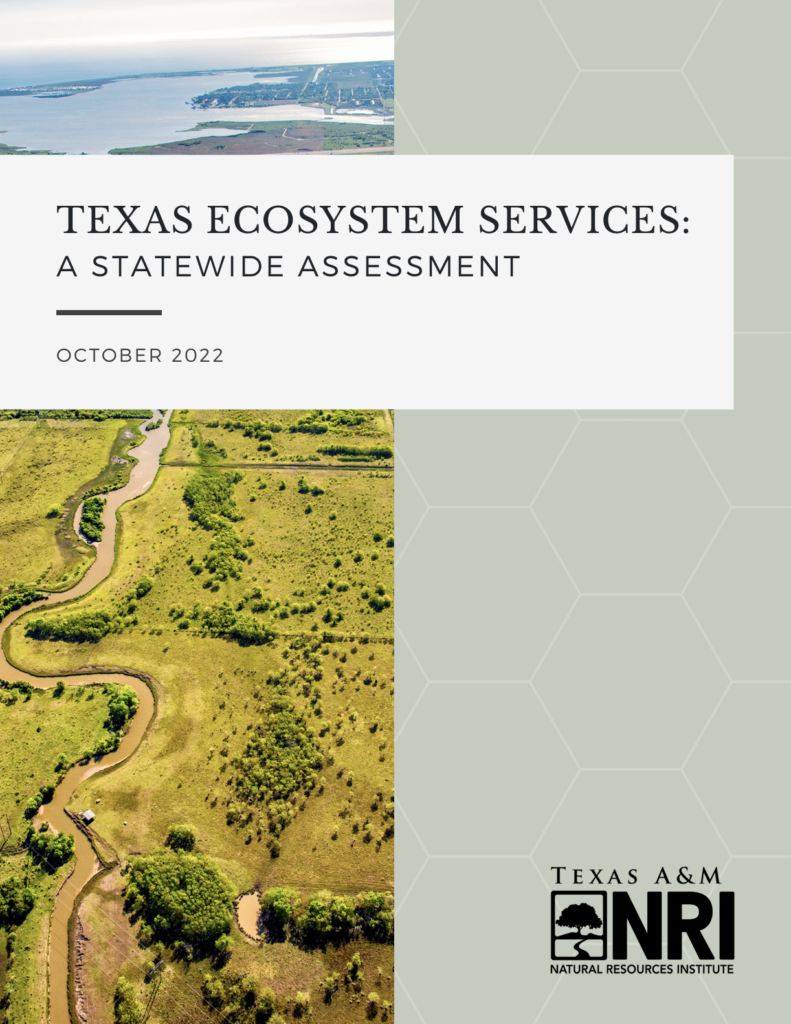Natural Resources Institute helps assess value of Texas’ ecosystem services
Report aims to educate Texans and guide land conservation efforts
Can you put a price on clean air, water or white-tailed deer? The Texas A&M Natural Resources Institute, NRI, partnered with other agencies to study and assess the value of these “commodities of nature” and subsequent losses associated with land use changes.

These commodities of nature, or ecosystem services, are the set of functions benefiting human wellbeing, encompassing many life-sustaining outputs such as climate regulation, air purification and pollination. Many of these ecosystem services are traditionally considered shared and free to society.
As a result, these services, such as clean air, clean water and flood control provided by healthy forest, range and wetland ecosystems, are commonly overlooked. Although of critical importance, ecosystem services typically lack formal market structures, and their value can be difficult to quantify appropriately.
The assessment is critical because Texas experienced a 15.9% growth in population—more than any other U.S. state—between 2010 and 2019. With no signs of slowing, this rapid growth and subsequent development places increased strain on the state’s natural resources and the services they provide all Texans.
“Some might ask how you put a dollar value on clean air and water,” said Roel Lopez, Ph.D., director of the NRI, a unit of Texas A&M AgriLife Research. “In some ways, these commodities of nature are arguably priceless. But, as a result, their contributions and importance are often assumed or missed altogether by the general public, government leaders and those involved in land-use decision making.”
To resolve this, researchers with NRI, Texas Agricultural Land Trust, TALT, and the U.S. Department of Agriculture’s Natural Resources Conservation Service, NRCS, conducted one of the first comprehensive, statewide assessments of Texas’ ecosystem services and assessment of the investments required to maintain their benefits. While the Texas A&M Forest Service published a statewide assessment in 2013, the document focused on forest-based ecosystem services.
Valuing the seemingly invaluable
Report author Addie Smith, geospatial specialist with NRI, said the team assigned a collective value in the assessment for four ecosystem service categories including provisioning, regulating, cultural and supporting services. Each category was uniquely defined based on attributes like tangible goods, ecosystem processes, non-material benefits and ecological functions.
The authors then assigned dollar values to ecosystem functions across the state based on market-based estimates from the Texas Comptroller of Public Accounts and the Texas Water Development Board where appropriate.
Willingness-to-pay estimates, defined as the maximum price a customer is willing to pay for a product or service, were determined from established federally funded field-scale or operation-level conservation programs administered through the NRCS. Examples include the Conservation Stewardship Program, Environmental Quality Incentives Program and the Regional Conservation Partnership Program.
To determine one total ecosystem service value for the whole of Texas, the authors summarized all values for each of the four ecosystem services categories.
“Taking a step back, we can now ask definitively what the cost of losing land is in Texas,” said Chad Ellis, chief executive officer of TALT. “By these conservative findings, it’s about $629 per acre or, when we consider that we’re losing about 640 acres per day to land conversion, it’s about $146,934,400 per year in ecosystem services value lost.”
The full report includes maps for each ecosystem service category from food and fiber production to flood mitigation and non-consumptive recreation. It reveals trends that will ultimately provide clarity for policymakers, conservation organizations and land managers regarding the full economic and ecological benefit Texas receives from vital open space lands, as well as the cost of overlooking their contribution to society.
“At the end of the day, we need to keep farmers, ranchers, forest owners—land stewards—on the land to grow food, conserve water and preserve wildlife habitat,” Lopez said. “Their work provides the environment where we all meet, where we all have a mutual interest, and that provides benefits that we all share.”


